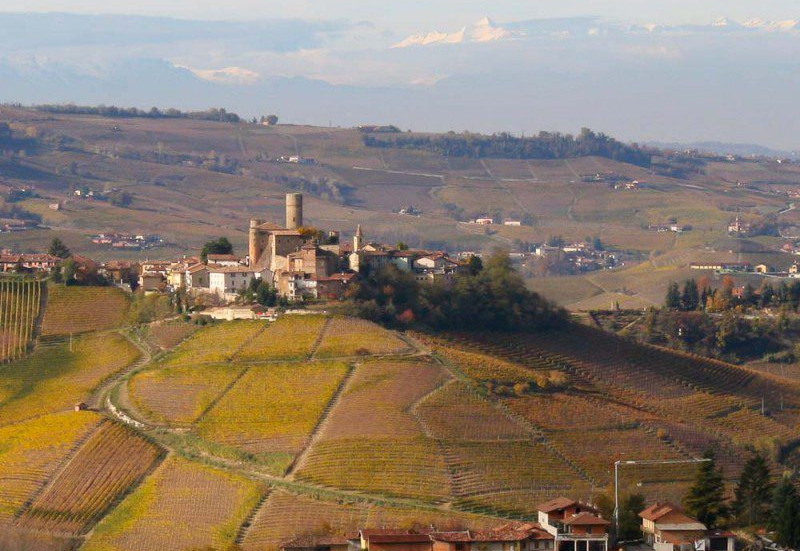⛰️ Langhe hills, the hidden beauty of Piemonte
- Tony Lcrx
- Jul 29
- 4 min read
Updated: Sep 1
🤝 Langhe hills: Alpine Terroir in a Mediterranean Setting
Nestled between Milan, Turin, and Genoa, the Langhe hills form the heart of Piemonte. This patchwork of rolling vineyard slopes surrounding Alba is home to some of Italy's most revered wines. Here, the climate is a gentle dance between Alpine and Mediterranean influences:

Cool, dry Alpine winds sweep down from the mountains at night.
Warm, humid breezes from the Mediterranean drift inland during autumn.
Winters are calm and cool;
Summers are warm but never scorching.
This unique climate, coupled with specific soils and deep-rooted traditions, makes the Langhe a sanctuary for terroir-driven wines.
🌿 Nebbiolo: The Pinot Noir of Italy
While global demand for Pinot Noir continues to surge, prices are soaring—especially in Burgundy...
Yet, Piemonte offers an equally compelling alternative: Nebbiolo, a native grape that shares Pinot Noir’s delicate sensitivity to soil, climate, and human touch.
In the Langhe, Nebbiolo expresses itself with clarity, echoing the uniqueness of each hillside. This is what we call terroir: a wine that genuinely reflects its origin—soil, climate, and the expression of the winemaker's hand. When one of these elements is missing, technique often overshadows others.
Out of the various wines produced here, there is 2 appellation leading the board with contrasting personalities:
Barolo – famed for its depth, complexity and aging power.
Barbaresco – refined, graceful, and more approachable in youth.
🌍 Soils: A puzzle of Influence

The geological story of Langhe is layered and complex, but we can simplify it into two dominant soil types that shape the character of the wines:
🪨 Tortonian sandy chalk
(lighter, well-drained):
Found in Barolo and La Morra
Produces elegant, perfu
🪨 Helvetian calcareous marl
Compact, clay-rich
Found around Serralunga and Monforte d'Alba
Yields structured, powerful, and age-worthy wines
🍇 Vinification Styles: Tradition Meets Modernity
As with all iconic wine regions, Barolo and Barbaresco have long been a battleground between tradition and modernity.
In the 1980s, a new wave of winemakers, dubbed the Barolo Boys, challenged the status quo. Led by Elio Altare, who famously destroyed his family’s centuries-old oak casks to make room for stainless steel and French oak barriques, this movement brought a dramatic shift to Piemonte winemaking.
📖 Traditionalists
Extended maceration (20–30 days)
Fermentation in open oak vats
Years of aging in large, neutral oak or large Slavonian botti
Wines are age-worthy, structured, and complex
Key Figures:
Giacomo Conterno – the standard-bearer for classic Barolo
Bruno Giacosa – master of elegance and terroir
Produttori del Barbaresco – a cooperative model of consistency and tradition
"We have never changed our style: long maceration, natural fermentations, and traditional botti." Aldo Vacca, Produttori del Barbaresco
🌟 Modernists
Short maceration (7–10 days)
Stainless steel fermentation with temperature control and powerful extraction
Aging in small French barriques, often new
Wines are fruit-forward, polished, and earlier-drinking
Key Figures:
Elio Altare – the rebel who launched the movement
Conterno Fantino – sleek, modern expressions with structure
Angelo Gaja – visionary of Barbaresco, master of innovation
"I’m not interested in making great Barolo. I simply want to make great wine." Elio Altare
📊 A Gray Mosaic
Today, Piemonte is less polarized. Many producers adopt a hybrid approach:
Temperature-controlled fermentations
Gentle extraction
Balanced oak use
Even icons like Aldo Conterno blend styles: modern fermentations with aging in large, neutral casks. Vineyard management has evolved too, with canopy care, green harvesting, and precise ripening strategies helping refine expression. Terroir is even more present than ever.
🌟 Recognition & Classification
UNESCO World Heritage Site (2014) -- To preserve the Langhe's vineyard landscapes
Known as "The Burgundy of Italy" for its complexity, sensitivity, and cru-level vineyard distinctions
In Barolo and Barbaresco, vineyards are now classified as MGA (Menzioni Geografiche Aggiuntive), akin to Burgundy's Climats.
Watch for names like Cannubi, Falletto, Pajé, or Bricco delle Viole. Then, you can reconize where your wine is coming from, with a true feeling of the place. The sunshine on the gentle slope, the earthyness of the soil, the specific aging the winemaker has choosed to best express its identity...
🍷 Your Glass, Your Story
Whether you're enchanted by the bold purity of Giacosa, the precision of Conterno Fantino, or the vision of Gaja, Piemonte offers a lifetime of discovery through a single grape.
🏡 Beyond Nebbiolo

Piemonte isn't only about Nebbiolo. Step outside the spotlight and discover:
Dolcetto – juicy, everyday red; think Gamay with an Italian soul
Barbera – dark fruit, natural acidity; perfect for Syrah lovers
Pelaverga – spicy, light-bodied, and rare; a hidden gem of Verduno
Arneis & Timorasso – Piemonte’s white expressions, from fresh to age-worthy
📲 Join the Journey
If you found a new curiosity about Piemonte or learned something today, leave me a like or a comment!
Give me your tought for the next region I should explore for you?
And remember:
Go out, taste something new, and step beyond your comfort zone ------------------------- You might just find your next favorite bottle.
Cheers all,
Tony Lécuroux MS
✨ Master Sommelier
🥈 Best Sommelier of Switzerland 2025












Comments